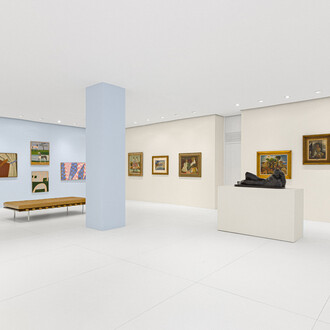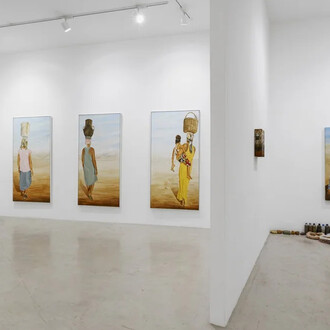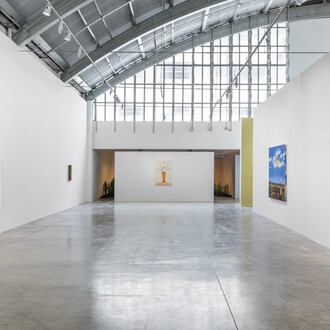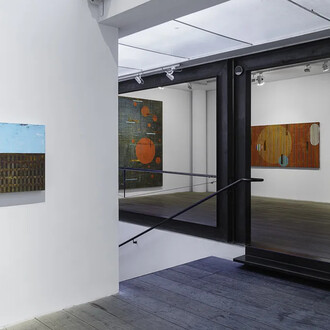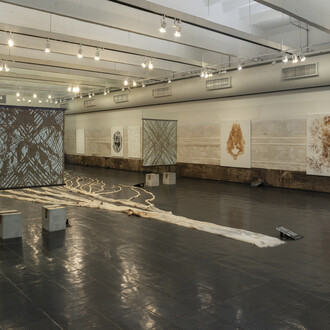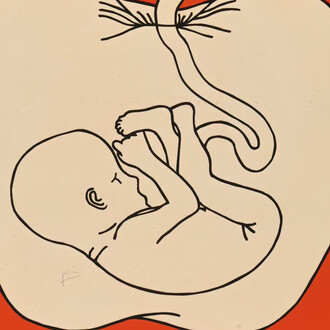Between 1985 and 1986, Martin Kippenberger left Cologne for Brazil. He was accompanied by photographer Ursula Böckler, who was invited to document the three-month tour. At this point, the artist was already a local hero in Western Germany: famous both for his work and histrionic personality. Kippenberger named his Brazilian expedition ‘The Magical Misery Tour’, as a parody of the famous Beatles album. The sardonic, irreverent tone is typically Kippenbergerian. The title was also the conceptual starting point for a series of artworks embedded in stereotypes, self-deprecation and tongue-in-cheek comments, which reveal his reliance on the moral and cultural authority supposedly bestowed by his German passport. Böckler’s pictures expose Kippenberger as a typical foreigner (or ‘gringo’): sunburnt, wearing shorts, topless, charmed by tropical misfortunes and keen to interpret them from his privileged position. At the time, the term ‘Third World’ was still widely used and the official contemporary art circuit was essentially restricted to New York, London and Cologne.
Almost 20 years earlier, Torquato Neto wrote ‘this is the end of the world’ in the chorus of his song Marginália II, recorded by Gilberto Gil in 1967. The poet from Piauí uses the typical eloquence of the Tropicália group to deconstruct Gonçalves Dias’ romantic nationalist statement. His cunning inter-textual exercise reveals the complex Brazilian reality under the military regime. This was the beginning of the so-called ‘leaden years’, when the exuberant experimentalism of Tropicália was about to be suppressed by the persecution and forced exile of the movement’s members, who had already triggered a true aesthetic revolution in the Brazilian cultural scene.
In 1971, Ivan Cardoso invited Torquato Neto to play the main role in Nosferatu no Brasil, a classic of the ‘Terrir’[1] genre: a term coined by poet Haroldo de Campos. In the same year, Neville de Almeida filmed the legendary Mangue-Bangue, a radical audio-visual collage shot in a red-light district in Rio de Janeiro, which the artist visited with Hélio Oiticica. Both films view the canon of Western cinema with suspicion, and show in their own way — through absurd tragicomedy and mockery — a Brazil threatened by authoritarianism and censorship.
The outcast and sunny version of the vampire Nosferatu, who drinks coconut water in Copacabana to the sound of bossa nova, could easily be one of Tiago Carneiro da Cunha’s caustic characters, which are also the starting point for this exhibition. In this text, my choice of getting to Carneiro da Cunha’s work via free association is a way of replicating the dynamics that has led us to the artworks exhibited in this show: a shared search for artists of different generations who, like him and the other examples cited above, opted to inhabit the fine line between the comic, the tragic, the melancholic and the seductive when critically representing and discussing the visual codes that constitute an idea of Brazilian cultural identity or, more widely, of the region that is conventionally known as Latin America in the globalized world and the so-called ‘international contemporary art circuit’ — which incidentally was being established at the time Kippenberger travelled to Brazil.
‘Yes, we have bananas’, and plenty of tropical melancholy on show. We have opted to create a cacophonic environment, full of free associations, semantic games, tributes, intertextuality, new readings and varied profanations. The displayed artworks challenge the idea of high and low culture, opting for the transgressive and the idiosyncratic as antidote against one-liner interpretations, closed discourses and unilateral standpoints. On this account, the choice of including one of the original images by Böckler — the only European artist in the show — portraying Kippenberger in Brazil is intended to highlight the autonomy of the photographer’s gaze in relation to the ambivalent approach of her travel companion’s project. In several images, Böckler’s lenses capture with embarrassment the movements of a bullish tourist-artist in a Brazil that had just left behind 20 years of military dictatorship. Ultimately, her shots are a relevant visual document of the mentality of an era.
In contrast to the ‘Magical Misery’ stylized by Kippenberger, the stereotyped territory that Carneiro da Cunha has been exploring for years, and that resonates in this exhibition, is the result of an intentional sublimation of a context that is intolerably real. By humorously evoking the canonical and the unspeakable, his production takes us closer to elements of our society that are so flagrant and traumatic that they defy any reason. In a world where the narratives of the news are not far from fantastical, Carneiro da Cunha’s muddy monsters and cheeky devils, and even Lina Bo Bardi’s scatological Polochon, no longer seem outlandish, instead, they remind us of the aggregating and subversive power of humor as a starting point for a critical reflection of deep-rooted social dynamics that are in need of revision.
Curator Fernanda Brenner







![Bruno Munari (1907-1998)
Forchetta parlante, 1958-1991, Ed. 18/20
Garfo torcido sobre madeira
[Bent fork on wood]
15 x 7 x 3 cm [5 7/8 x 2 3/4 x 1 1/8 in.]](http://media.meer.com/attachments/582ae4ad2069da3df8b04376669e19755ef38c25/store/fill/330/330/fddfcc2bc266d3812450a83789a0c87812d6adba2c5fe72080b1c3b22654/Bruno-Munari-1907-1998-Forchetta-parlante-1958-1991-Ed-18-slash-20-Garfo-torcido-sobre-madeira.jpg)
![Bruce Conner (1933-2008)
BREAKAWAY, 1966
Filme 16mm em preto e branco
[Black and white 16mm film]
5 min
BC-0019
Courtesy: The Conner Family Trust, Kohn Gallery and Bergamin & Gomide](http://media.meer.com/attachments/7d07aa708db7f25e05333b5b262166f49883bfa7/store/fill/330/330/839c49e290870e0a9fe994df5e0c140d163ec7ca78a6019e5e8b269855f1/Bruce-Conner-1933-2008-BREAKAWAY-1966-Filme-16mm-em-preto-e-branco-Black-and-white-16mm-film-5.jpg)
